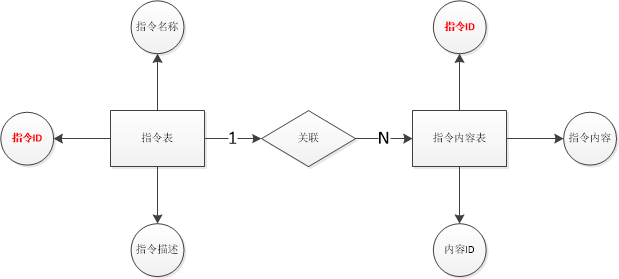Mybatis的一对多关系的配置
今天学习的是Mybatis下的一对多的关系配置。
首先放出的是表的ER图,方便大家理解。

简单的说明一下,这两张表有一对多的关系,也就是说,一条指令对应了多条的指令内容,那么在这样的关系下,mybatis如何去配置。
根据ER图,我们开始在MySQL编写表的结构
command表
CREATE TABLE `command` ( `ID` int(11) NOT NULL AUTO_INCREMENT, `NAME` varchar(255) DEFAULT NULL, `DESCRIPTION` varchar(255) DEFAULT NULL, PRIMARY KEY (`ID`) ) ENGINE=MyISAM AUTO_INCREMENT=3 DEFAULT CHARSET=utf8;
command_content表
CREATE TABLE `command_content` ( `ID` int(11) NOT NULL AUTO_INCREMENT, `CONTENT` varchar(255) NOT NULL, `COMMAND_ID` int(11) NOT NULL, PRIMARY KEY (`ID`) ) ENGINE=MyISAM AUTO_INCREMENT=8 DEFAULT CHARSET=utf8;
java代码部分,我们先编写这两个表的实体类
/** * 与指令表对应的实体类 */ public class Command { /** * 主键 */ private String id; /** * 指令名称 */ private String name; /** * 描述 */ private String description; /** * 一条指令对应的自动回复内容列表 */ private List<CommandContent> contentList; public String getId() { return id; } public void setId(String id) { this.id = id; } public String getName() { return name; } public void setName(String name) { this.name = name; } public String getDescription() { return description; } public void setDescription(String description) { this.description = description; } public List<CommandContent> getContentList() { return contentList; } public void setContentList(List<CommandContent> contentList) { this.contentList = contentList; } }
/** * 与指令内容表对应的实体类 */ public class CommandContent { /** * 主键 */ private String id; /** * 自动回复的内容 */ private String content; /** * 关联的指令表主键 */ private String commandId; public String getId() { return id; } public void setId(String id) { this.id = id; } public String getContent() { return content; } public void setContent(String content) { this.content = content; } public String getCommandId() { return commandId; } public void setCommandId(String commandId) { this.commandId = commandId; } }
到mapper,我们需要编写两个映射文件
<?xml version="1.0" encoding="UTF-8"?> <!DOCTYPE mapper PUBLIC "-//mybatis.org//DTD Mapper 3.0//EN" "http://mybatis.org/dtd/mybatis-3-mapper.dtd"> <mapper namespace="Command"> <resultMap type="com.imooc.bean.Command" id="CommandResult"> <id column="C_ID" jdbcType="INTEGER" property="id"/> <result column="NAME" jdbcType="VARCHAR" property="name"/> <result column="DESCRIPTION" jdbcType="VARCHAR" property="description"/> <collection property="contentList" resultMap="CommandContent.Content"></collection> </resultMap> <select id="queryCommandList" parameterType="com.imooc.bean.Message" resultMap="CommandResult"> select a.ID C_ID,a.NAME,a.DESCRIPTION,b.ID,b.CONTENT,b.COMMAND_ID from COMMAND a left join COMMAND_CONTENT b on a.ID = b.COMMAND_ID <where> <if test="name!=null and !"".equals(name.trim())"> and NAME = #{name} </if> <if test="description!=null and !"".equals(description.trim())"> and DESCRIPTION like '%' #{description} '%' </if> </where> </select> </mapper>
<?xml version="1.0" encoding="UTF-8"?> <!DOCTYPE mapper PUBLIC "-//mybatis.org//DTD Mapper 3.0//EN" "http://mybatis.org/dtd/mybatis-3-mapper.dtd"> <mapper namespace="CommandContent"> <resultMap type="com.imooc.bean.CommandContent" id="Content"> <id column="ID" jdbcType="INTEGER" property="id"/> <result column="CONTENT" jdbcType="VARCHAR" property="content"/> <result column="COMMAND_ID" jdbcType="INTEGER" property="commandId"/> </resultMap> </mapper>
通过以上的配置,我们就可以实现两张表的一对多关系的配置了。

